|
Glass
was an untried medium for BV at the start of the sixties. Undaunted,
he set about the task with frenetic energy to create work, the magnitude
and quality of which was breathtaking to audiences and critics alike.
Vallien's glass creations from the sixties are an outpouring of
his creative imagination - an explosion of form, colour and technical
innovation.
During
college years and his first year at Åfors there was a marked
polarisation in the approach to art and design: classicism versus
a more personalised style of expression. The artist/designers who
were attached to the glassworks in the first half of the 20th century
were often skilful painters with the ability to produce designs
of great excellence, which were translated by skilled artisans into
artefacts of great beauty. The pure, sober lines of the classical
style, which came to be known throughout the world as "Swedish
Modern" reached a zenith in the 1950s, in which decade modernism
made an entrance into Sweden. The major influences derived from
America and included jazz music, the action painting of Jackson
Pollock, Jack Kerouac's beatnik ideology, and sculptural pottery.
The new generation of industrial artists had a different kind of
training, and a modernist outlook. The fifties saw a revolution
in Swedish artistic glass. At the forefront was a young sculptor
named Erik Höglund, who had been engaged by the Boda glass-factory
in 1953.
Bertil
first encountered modernism through his teacher, Stig Lindberg,
at the College. Lindberg and the sculptress Hertha Hillfon, were
among the pioneers of expressionism and opposed to the cult of manual
skill. In the absence of facilities (i.e. a kiln) at the college,
the students would instead visit the large factories in Småland.
The favourite was Boda, where the charismatic Höglund had achieved
a breakthrough. There was a certain rapport between the two artists;
they shared a lust for life, tremendous creative energy and a colourful
personality.
From
1963 Höglund was joined by Vallien, who was now an acclaimed
international glass- artist. That Åfors became his workplace
is due, he believes, to the fact that the factory was in need of
an artist, and was run by the same man who hired Höglund -
Erik Rosen, legendary director of Boda for three decades:
-It gave
them a chance to experiment and to develop their talents. I gave
them my support, and was also thinking ahead.
In 1964
the Boda glass factory celebrated its centenary with a manifestation
of its products at the Nordiska Galleriet in Stockholm, where Bertil's
first collections were shown. One of his very first pieces of artistic
glass was an engraved glass bubble mounted on a wooden plinth; it
was acquired by the National Museum of Fine Art.
Vallien
applied his view of art and his American experiences to the practical
work at Åfors. What he lacked in experience of the material
he made up for with curiosity and experimentation in the 'hot-shop'
(glass-house/workshop). Like Höglund, he explored innovative
techniques in his search for a new mode of expression. He exploited
the natural sculptural properties of the glass to create bowls,
dishes and bottles - such as the swelling mould-blown glass bottles
he created throughout the sixties. (They are offset by a quadrangular
base.) Where decoration is concerned he invented a new method, using
carpenters glue in place of stencils, which gave him greater freedom
to control the patterns. He used the paste to create a myriad unusual
patterns. Here, too, there is an effective contrast between the
roughness of the sandblasted surfaces and the transparent glass.
Vallien
saw his sand-blasted glass artefacts, not as beautiful objects,
but as freestanding works of art. The idea was a controversial one
in the sixties, when the borderline between art and handicraft was
a subject of fervent/hot debate. Vallien presented his argument,
clearly and concisely in Design magazine, 1965, and attracted maximum
attention:
"Manual
skill should never be an end in itself. On the contrary, I try to
distance myself from it, as it can hinder creativity. If one is
too technically driven, it can become a fixation. All you achieve
is virtuosity. A technical skill, devoid of emotion; merely a display
of manual skill. This can lead to a mannered style. Personally,
I often draw with my left hand as a means of avoiding the skill
that my right hand has developed. A kind of aesthetic romanticism
attaches to Swedish art-handicraft, especially in ceramics; there's
a certain type of ceramist who is in love with his medium; - a beautiful
material to be worked, glazed and fired. For many that's enough.
They've forgotten the emotional content: all it is is a demonstration
of the medium. You can compare it to gathering stones on the beach
- which in themselves are amazingly beautiful. Though selecting
them can also be an art. I do feel that there's a tendency - a desire
to get away from a romanticising of the medium, and to give a conscious
value to the objects."
Vallien
took a crucial step towards glass as art when he began experimenting
with sand-casting, a technique that was relatively unknown to the
glass industry. (The Swedish artist/ceramicist, Anders Liljefors,
made use of the technique for his stoneware sculptures). BV was
interested in trying out the technique at Åfors. And with
that a new era in the art of glass with novel sculptural possibilities
was initiated. At the same time the road to technical resolution
was an arduous one. Sandcasting is a carefully prepared piece of
teamwork. The dampened red sand is placed in metal boxes a day in
advance. Firstly a wooden mould is pressed into the sand and in
the cavity so formed, Bertil prepares the surface with powdered
paint, and the various figures that are to be enclosed by/in the
molten glass*. When it is time for casting the team of artisans
work rapidly with optimal concentration. The heat from the many
ladles of molten glass that are poured into the cavity is ferocious
. The sculpture is fired with Calor gas to prevent the warm glass
from get fixed. The actual casting is over in a few minutes and
now the most critical part of the process awaits, the cooling process.
For a long time there was a problem with uneven temperature in the
cooling oven. A third of the products were cracked after the three
weeks in the oven. Now things have improved a lot, thanks to computerized
temperature control.
Vallien
made his first sandcastings in 1963. The first sculptures from the
sixties have a primitive appearance. "The Glassman" (1964)
and "Clean force" (1965), are among the earliest examples.
The technique was then in its infancy. The fifty centimetres high
Pure Energy resembles/is an ancient tree or human being, flexing
his muscles. The rough surface and simple shape of the piece associates
to prehistoric times. A series of mobile sculptures, made in 1967
are some of BV's most fascinating pieces. The Goddess N is an unknown
quantity - her chariot descends, laden with secrets and mystic power.
It was
not long before BV made a breakthrough and was critically acclaimed.
Sweden now had a new fixed star alongside Erik Högberg. The
manifold newspaper-cuttings from the 60s bear witness to an artistic
personality with a great mass medial impact. A word that often appears
in the articles is "overwhelming": Beside the traditional
descriptions of exhibitions there are contributions from Bertil
- as the foremost spokesman for art glass in the debate on art and
art-handicraft. At the end of the sixties his statements became
increasingly more critical. From 1967 onwards the prevailing view
of fine art and handcraft began to crack. Bertil delivered a couple
of sound blows/smacks in the face to Form, Swedish Modern and the
aesthetes. One by way of "Young Glass", a joint exhibition
with Finnish colleague Oiva Toikka, at NK, 1967; the other with
his book 'Handicraft in the 60s', 1968, in which he made known his
viewpoints.
The two countries in which Vallien attracted most attention were
the US and Australia. One New York newspaper described him as a
"Swedish Rebel", with a penchant for "ugly beauty".
In Australia he was known as "The Glass Man" (in conjunction
with an exhibition there in 1968).
It is
symptomatic that Bertil participated in the exhibition "Feel
It", 1968, which was shown at the National Museum of Fine Art,
Stockholm and the Museum of Contemporary Crafts in New York. Together
with Olle Adrin, Erik Höglund, architects Gustaf Clason and
Eric Sörling and composers Leo Nilsson and Ralph Lundsten,
he produced an exhibition that emphasised the sensual as opposed
to the functional. The exhibition space was composed in the way
a person with impaired sight would perceive it. Bertil's contribution
to the show was a mirrorscape. The exhibition reflected his own
ideas on art: of communication between perceiver and work, and an
experience of function and content, without limitation.
The 1960s
signified a breakthrough for freer expression in the field of Swedish
glass. While Vallien was in the centrestage, there was no going
back to the old traditional style. With the sandcasting technique
he had found an innovative platform for his free sculptural work.
During the following decades he would deepen/broaden the artistic
|

BV
in his studio, 1965.

Sand
- blasted bowls, mid 60s.

Sand
- blasted vase.
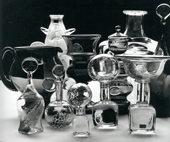
A
still life with artglass around 1964. Photo: Ola Terje.
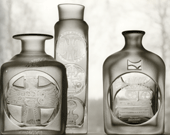
Sand
- blasted and engraved bottles. Photo: Arne Wolf.
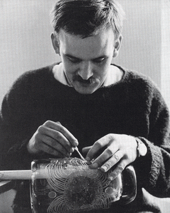
Bertil
does some preparation on vase.
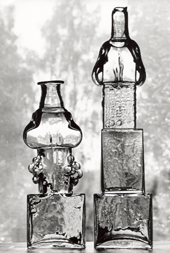
Bottles,
1967. Photo: Sten Robért.

Clean
force, sand - casted sculpture from 1965. Photo: Ola Terje.
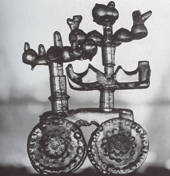
Godness
N, sand - casted sculpture from 1967.

Toys
for Prince, 1967. Photo: Per Larsson.

Tall
vase,
1968. Photo: Sten Robért.
|


